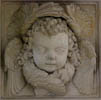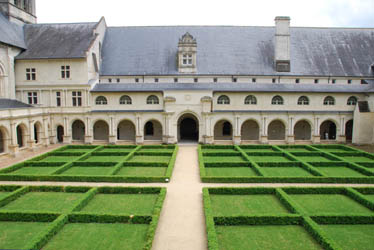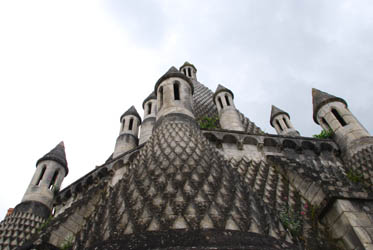The Royal Abbey of Fontevraud: Counts of Toulouse, the Dukes of Aquitaine and the
Kings of England
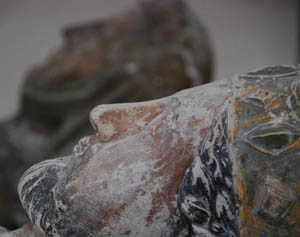  Fontevraud is a large spectacular abbey in the Loire. From its early years it was favoured by the Counts of Anjou. Henry II and his queen Eleanor of Aquitaine were both benefactors. Two of their children John and Jeanne (Joan) were raised partly here, and women in the family often became nuns here. Fontevraud is a large spectacular abbey in the Loire. From its early years it was favoured by the Counts of Anjou. Henry II and his queen Eleanor of Aquitaine were both benefactors. Two of their children John and Jeanne (Joan) were raised partly here, and women in the family often became nuns here.
Eleanor retired to Fontevraud, and died here in 1204. She was buried along with other members of her family who had predeceased her: her husband Henry and two of their children Richard and Jeanne had already been buried here. Fontefraud became the burial place for the Plantagenates. The bodies or the hearts of the following were intered here:
- Henry II, King of England, Count of Anjou . Today a stone effigy of the King lies in the nave of the Abbey church at Fontevraud.
- Eleanor of Aquitaine, Duchess of Aquitaine, wife of Henry II, Queen of England and sometime Queen of France. Today a stone effigy of the Queen lies in the nave of the Abbey church at Fontevraud.
- Richard I, King of England, Duke of Aquitaine, Count of Poitou, son of Henry II and Eleanor. Richard had quarelled with his father but repented on his way to Fontevraud for his father's burial and asked to be buried at the same place when his time came. He was intererred here in April 1199 just three months before his sister Jeanne. His effigy lies at the feet of his father's. Today a stone effigy of the King lies in the nave of the Abbey church at Fontevraud.
- John, King of England, son of Henry II and Eleanor, whose heart was brought here for burial.
- Isabelle of Angouleme, queen of England, wife of King John and Mother of Henry III , who became a nun here before her death. Today a wooden effigy of the Queen lies in the nave of the Abbey church at Fontevraud.
- Henry III, King of England (son of John and Isabelle) whose heart was brought here for burial.
- Jeanne (Joan) of England, daughter of Henry II and Eleanor, wife of Raymond VI of Toulouse, mother of Raymond VII, Count of Toulouse who was buried here in July 1199 along with her father and brother Richard. Before her death she had become a nun at Fontevraud.
- Raymond VII of Toulouse, son of Raymond VI and Jeanne, grandson of Henry II and Eleanor
- Richard, son of Raymond VI and Jeanne, grandson of Henry II and Eleanor, brother of Raymond VII (and nephew of the Lionheart after whom he was named) who died in infancy.
    Fontevraud Abbey (or Fontevrault Abbey) is located in the village of Fontevraud-l'Abbaye, near Chinon, in Anjou. It was founded by an itinerant preacher called Robert of Arbrissel, who had just created the Order of Fontevrault, a new monastic order. Fontevraud Abbey (or Fontevrault Abbey) is located in the village of Fontevraud-l'Abbaye, near Chinon, in Anjou. It was founded by an itinerant preacher called Robert of Arbrissel, who had just created the Order of Fontevrault, a new monastic order.
The first permanent structures were built between 1110 and 1119. The abbey was a double monastery, which means that both monks and nuns occupied the same site. The Order of Fontevrault became an international success, with monasteries throughout Europe.
  Unusually, Robert of Arbrissel declared that the leader of his new order should always be a woman and appointed Petronille de Chemillé as the first abbess. She was succeeded by Matilda d'Anjou, the aunt of Henry II of England . The position of Abbess attracted many rich and noble women, including members of the French Bourbon royal family. The tasteless Louise de Bourbon left her arms and monogram on many of the embellishments she made during her term of office. Unusually, Robert of Arbrissel declared that the leader of his new order should always be a woman and appointed Petronille de Chemillé as the first abbess. She was succeeded by Matilda d'Anjou, the aunt of Henry II of England . The position of Abbess attracted many rich and noble women, including members of the French Bourbon royal family. The tasteless Louise de Bourbon left her arms and monogram on many of the embellishments she made during her term of office.
In the early years the Plantagenets were benefactors of the abbey and while Isabella d'Anjou was abbess, Henry II's wife Eleanor of Aquitaine became a nun here, as later did her daughter, Jeanne of England.
  During the French Revolution, the order was dissolved. On 17 August 1792, a Revolutionary decree ordered the evacuation of all monasteries by 1 October of the same year. The last abbess, one Madame d'Antin later died in poverty in Paris. During the French Revolution, the order was dissolved. On 17 August 1792, a Revolutionary decree ordered the evacuation of all monasteries by 1 October of the same year. The last abbess, one Madame d'Antin later died in poverty in Paris.
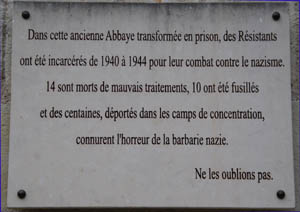  The abbey became a prison from 1804 to 1963, including the war years. The plaque on the right reads "In this abbey, converted into a prison, members of the Resistance were incarcerated from 1940 to 1944 for fighting against Nazism. 14 died of ill treatment, 10 were shot and hundreds deported to concentration camps experienced the horror of Nazi barbarism. Do not forget them". The abbey became a prison from 1804 to 1963, including the war years. The plaque on the right reads "In this abbey, converted into a prison, members of the Resistance were incarcerated from 1940 to 1944 for fighting against Nazism. 14 died of ill treatment, 10 were shot and hundreds deported to concentration camps experienced the horror of Nazi barbarism. Do not forget them".
In 1963 the abbey was given to the French Ministry of Culture.
The restoration of the abbey church started in the early twentieth century under the architect Lucien Magne and continues into the twenty-first.
The abbey was originally site of the tombs of King Henry II of England, his wife Eleanor of Aquitaine, their son Richard I of England (The Lionheart), their daughter Jeanne of England, their grandson Raymond VII of Toulouse, and Isabella of Angoulême, wife of their son King John. However, there is no remaining corporal presence of Henry, Eleanor, Richard or the others on the site. Their remains were destroyed during the French Revolution.
Henry II, King of England     Henry, By the Grace of God, King of the English and Duke of the Normans and Aquitanians, Count of the Angevins and Lord of Ireland. (5 March 1133 – 6 July 1189) Henry, By the Grace of God, King of the English and Duke of the Normans and Aquitanians, Count of the Angevins and Lord of Ireland. (5 March 1133 – 6 July 1189)
  Henry II was called "Curtmantle" because of his short robe. He ruled as King of England (1154–1189), Count of Anjou, Duke of Normandy, Duke of Aquitaine, Duke of Gascony, Count of Nantes, Lord of Ireland and, at various times, ruled parts of Wales, Scotland and western France. Henry II was called "Curtmantle" because of his short robe. He ruled as King of England (1154–1189), Count of Anjou, Duke of Normandy, Duke of Aquitaine, Duke of Gascony, Count of Nantes, Lord of Ireland and, at various times, ruled parts of Wales, Scotland and western France.
Henry was the first of the House of Plantagenet to rule England and attempted to annex Ireland in compliance with a papal bull.
Weak, ill, and deserted by all but an illegitimate son, Geoffrey, Archbishop of York, Henry died at Chinon on 6 July 1189. His legitimate children, chroniclers record him saying, were "the real bastards.". The victorious Richard paid his respects to Henry's corpse as it travelled to Fontevraud Abbey, upon which, according to Roger of Wendover, 'blood flowed from the nostrils of the deceased, as if ... indignant at the presence of the one who was believed to have caused his death'.
     His tomb was destroyed during the French Revolution. Today, his effigy rests in the Abbey of Fontevraud next to his wife Eleanor of Aquitaine. The arms of England depicted in a window at the abbey show the three lions of England, though in his lifetime Henry seems always to have used his two lions as Count of Anjou. His tomb was destroyed during the French Revolution. Today, his effigy rests in the Abbey of Fontevraud next to his wife Eleanor of Aquitaine. The arms of England depicted in a window at the abbey show the three lions of England, though in his lifetime Henry seems always to have used his two lions as Count of Anjou.
Richard, Henry's oldest living son, was crowned Richard I of England on 1 September 1189.
Eleanor of Aquitaine ( Aliénor d'Aquitània, Aliénor d'Aquitània,  Eléanor d'Aquitaine) Eléanor d'Aquitaine)
  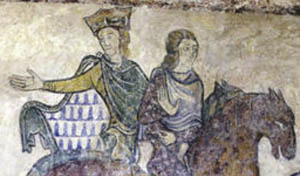  Eleanor of Aquitaine (or Aliénor), Duchess of Aquitaine and Gascony and Countess of Poitou (1122 – 1 April 1204) was one of the wealthiest and most powerful women in Europe during the High Middle Ages. Eleanor of Aquitaine (or Aliénor), Duchess of Aquitaine and Gascony and Countess of Poitou (1122 – 1 April 1204) was one of the wealthiest and most powerful women in Europe during the High Middle Ages.
She was the daughter of Guilhem (William) X Duke of Aquitaine and granddaughter of Guilhem (William) IX Duke of Aquitaine, famous today as the first troubadour
  Eleanor of Aquitaine was Queen consort of both France (to Louis VII) and England (to Henry II) and the mother of two kings of England, Richard I and John. She is well known for her participation in the Second Crusade. Eleanor of Aquitaine was Queen consort of both France (to Louis VII) and England (to Henry II) and the mother of two kings of England, Richard I and John. She is well known for her participation in the Second Crusade.
Eleanor died in 1204 and was entombed in Fontevraud Abbey
next to her husband Henry II and her son Richard I. Her tomb
effigy is decorated with magnificent jewelery She is depicted
reading a book, a mark of her great culture, the ability to
read being exceptional for a layman and even more for a woman
in an age when the church discouraged all learning.
Richard I, King of England   Richard, By the Grace of God, King of the English and Duke of the Normans and Aquitanians, Count of the Angevins and Lord of Ireland Richard, By the Grace of God, King of the English and Duke of the Normans and Aquitanians, Count of the Angevins and Lord of Ireland
Richard I (September 8, 1157 – April 6, 1199) was King of England and ruler of the Angevin Empire from July 6, 1189 until his death.
  He was known as Richard the Lionheart, or Cœur de Lion, even before his accession because of his reputation as a military leader. He was known as Richard the Lionheart, or Cœur de Lion, even before his accession because of his reputation as a military leader.
At 16, Richard had his own command, putting down rebellions in Poitou against his father, Henry II. Richard was a central Christian commander during the Third Crusade, leading the campaign after the departure of Philip Augustus, and gaining victories against his Muslim counterpart, Saladin.
  He spoke very little English - his first language was Occitan and spent very little time (6 months over 10 years) in his Kingdom, preferring to use it as a source of revenue to support his continental armies. He spoke very little English - his first language was Occitan and spent very little time (6 months over 10 years) in his Kingdom, preferring to use it as a source of revenue to support his continental armies.
In March 1199, Richard was in the Limousin suppressing a revolt by Viscount Aimar V of Limoges. He "devastated the Viscount's land with fire and sword" and besieged the lightly armed castle of Chalus-Chabrol. Some chroniclers claimed that the siege was motivated by a local peasant discovering a treasure trove of Roman gold, which Richard claimed as feudal overlord.
  In the early evening of March 25, 1199, Richard was walking around the castle perimeter without his chain mail, investigating the progress of sappers on the castle walls. A man standing on the walls aimed his crossbow at the king, and a quarrel struck him in the left shoulder near the neck. He tried to pull it out but failed. A surgeon removed it 'carelessly mangling' the King's arm in the process. The wound became infected and then gangrenous. In the early evening of March 25, 1199, Richard was walking around the castle perimeter without his chain mail, investigating the progress of sappers on the castle walls. A man standing on the walls aimed his crossbow at the king, and a quarrel struck him in the left shoulder near the neck. He tried to pull it out but failed. A surgeon removed it 'carelessly mangling' the King's arm in the process. The wound became infected and then gangrenous.
Richard asked to have the crossbow man brought before him. He turned out to be a boy. The boy claimed that Richard had killed his father and two brothers, and that he had killed Richard in revenge. The boy expected to be executed but Richard forgave the him, saying, "Live on, and by my bounty behold the light of day,". He ordered the boy to be freed and sent away with 100 shillings. Richard then set his affairs in order, bequeathing all his territory to his brother John and his jewels to his nephew Otto.
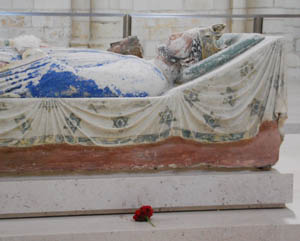  Richard died on Tuesday, 6 April 1199 in the arms of his mother Eleanor of Aquitaine. His final act of chivalry proved fruitless as his mercenary captain Mercadier had the crossbow man skinned alive and hanged as soon as Richard was dead. Richard died on Tuesday, 6 April 1199 in the arms of his mother Eleanor of Aquitaine. His final act of chivalry proved fruitless as his mercenary captain Mercadier had the crossbow man skinned alive and hanged as soon as Richard was dead.
Richard's brain was buried at the abbey of Charroux in Poitou, his heart was buried at Rouen in Normandy, and the rest of his body was buried at the feet of his father at Fontevraud Abbey.
He remains one of the few Kings of England remembered by his epithet, and is an enduring, iconic figure in England.
King John
    John, By the Grace of God, King of England, Lord of Ireland, Duke of Normandy and
Aquitaine and Count of Anjou John, By the Grace of God, King of England, Lord of Ireland, Duke of Normandy and
Aquitaine and Count of Anjou
John (24 December 1167 – 19 October 1216) reigned as King of England from 6 April 1199, until his death.
He succeeded to the throne as the younger brother of Richard I. John acquired the nicknames of "Lackland" ( Sans Terre) for his lack of an inheritance as the youngest son and for his loss of territory to France, and as "Soft-sword" because of his military ineptitude. Sans Terre) for his lack of an inheritance as the youngest son and for his loss of territory to France, and as "Soft-sword" because of his military ineptitude.
King John is best known for sealing Magna Carta, a document that limited his power, popularly regarded as an early first step in the evolution of modern democracy.
John was such a bad king that the barons eventually felt obliged to invite the King of France to come and take the English throne. Retreating from the resulting French invasion, John took a safe route around the marshy area of the Wash to avoid the rebel-held area of East Anglia. His baggage train including the Crown Jewels took a direct route across the marshes and was lost to the incoming tide. This loss dealt John a blow, which affected his health and perhaps his state of mind.
Succumbing to dysentery he died on 18 October (or possibly 19 October) 1216, at Newark Castle. Numerous accounts circulated soon after his death asserted that he had been killed by poisoned ale, poisoned plums or a surfeit of peaches.
He was buried in Worcester Cathedral, though his heart was sent for burial at Fontevraud.
His nine-year-old son succeeded him and became King Henry III of England (1216–72),
Queen Isabelle, Isabelle of Angouleme
In 1189, John was married to Isabel of Gloucester, but eleven years later he marries another Isabelle.
On 24 August 1200 John married Isabella of Angoulême, who was twenty years his junior. She was the daughter of Aymer Taillefer, Count of Angouleme. Characteristically, John had kidnapped her from her fiancé, Hugh X of Lusignan.
Isabelle bore five children:
- King Henry III of England (1207-1272).
- Richard, 1st Earl of Cornwall (1209-1272).
- Joan (1210-1238), Queen Consort of Alexander II of Scotland.
- Isabella (1214-1241), Consort of Frederick II, the Holy Roman Emperor.
- Eleanor (1215-1275), who married William Marshal, 2nd Earl of Pembroke, and later Simon de Montfort, 6th Earl of Leicester.
|
|


|
This William Marshal was the son of William the Marshal, the best example of the knightly ideal in all Medieval Europe.
Simon V de Montfort, 6th Earl of Leicester (1208 – August 4, 1265) was the son of the Simon IV de Montfort who led the Crusade against the Cathars of the Languedoc, a war against Raymonds VI and VII of Toulouse. Simon V was the principal leader of the baronial opposition to his brother-in-law Henry III. After the rebellion of 1263-1264, de Montfort became de facto ruler of England and called the first directly-elected parliament in medieval Europe. Because of this, de Montfort is today regarded as one of the progenitors of modern parliamentary democracy.
Henry III, King of England 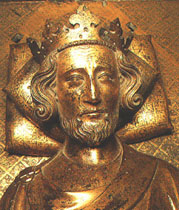  Henry, By the Grace of God, King of England, Lord of Ireland, Duke of Normandy and
Aquitaine and Count of Anjou Henry, By the Grace of God, King of England, Lord of Ireland, Duke of Normandy and
Aquitaine and Count of Anjou
Henry III (1 October 1207 – 16 November 1272) was the son and successor of John"Lackland" as King of England, reigning for fifty-six years from 1216 to his death. At the age of 9 he was the first child-king in England since the reign of Ethelred the Unready.
He assumed the crown under the regency of the popular William Marshal. He spent much of his reign fighting the barons over the Magna Carta and royal rights, and was eventually obliged to call the first "parliament" in 1264. He was unsuccessful on the Continent, where he tried to re-establish English control over Normandy, Anjou, and the Aquitaine, lost by his incompetent father.
  Despite his long reign, his personal accomplishments were slim and he is generally recognised to be a political and military failure, like his father John. His greatest accomplishment is the Palace of Westminster which he made the seat of his government and next to it Westminster Abbey conceived as a shrine to Edward the Confessor. Despite his long reign, his personal accomplishments were slim and he is generally recognised to be a political and military failure, like his father John. His greatest accomplishment is the Palace of Westminster which he made the seat of his government and next to it Westminster Abbey conceived as a shrine to Edward the Confessor.
England prospered during his reign, despite rather than because of him.
Jeanne (Joan) of England
Jeanne was born at Angers, in Anjou. She spent her youth at her mother's courts at Winchester and Poitiers. She was Richard I 's favourite sister. In 1176, King William II of Sicily sent ambassadors to England to ask for Jeanne's hand in marriage. The betrothal was confirmed and on August 27 Jeanne set sail for Sicily, escorted by an uncle and the bishop of Norwich.
In Saint-Gilles, the home town of the Counts of Toulouse, her entourage was met by representatives of the King of Sicily: After a hazardous voyage, the party arrived safely in Sicily, and on February 13, 1177, Jeanne married William II of Sicily and was crowned Queen of Sicily at Palermo Cathedral.
Jeanne of England was married in 1196 to Raymond VI of Toulouse, with Quercy and the Agenais as her dowry. The marriage took place in Beaucaire, presided over by Richard I himself. The following year she bore a son, also called Raymond, later to become Raymond VII of Toulouse.
 Raymond does not seem to have treated his wife well, and Jeanne came to fear him and his nobles. In 1199, while pregnant with a second child, she was left to face a rebellion. She laid siege to the castle of the ringleaders, the lords of Saint-Félix-de-Caraman les Cassès. Fearing treachery from her own troops she fled to the Limousin, hoping for Richard's protection, but she found him dead at Chalus. Raymond does not seem to have treated his wife well, and Jeanne came to fear him and his nobles. In 1199, while pregnant with a second child, she was left to face a rebellion. She laid siege to the castle of the ringleaders, the lords of Saint-Félix-de-Caraman les Cassès. Fearing treachery from her own troops she fled to the Limousin, hoping for Richard's protection, but she found him dead at Chalus.
She then fled to the court of her mother, Eleanor of Aquitaine, at Rouen, where she found refuge. Jeanne subsequently asked to be admitted to Fontevrault Abbey. She died there in childbirth, aged thirty-four years old, a veiled nun. In the west at this time, caesarean operations invariably meant death for the mother, and in this case for the baby too. It was a second son who lived long enough to be baptised Richard after his recently dead uncle.
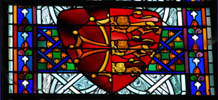  Jeanne was buried at Fontevrault Abbey along with her brother Richard, and presumably her son Richard. Later they would be joined by Eleanor of Aquitaine and fifty years later by her first son Raymond VII of Toulouse. Jeanne was buried at Fontevrault Abbey along with her brother Richard, and presumably her son Richard. Later they would be joined by Eleanor of Aquitaine and fifty years later by her first son Raymond VII of Toulouse.
Two sets of arms in the abbey church appear to represent Jean of England, Countess of Toulouse, combining the arms of Toulouse and of England.
In the early period of heraldry arms would be combined by a technique known as dimidiation. In this system the dexter side of one shield was combined with the sinister side of another, in this case the the dexter side is Toulouse (Jeanne's husband), and the sinister England (Jeanne's father)
|
|
+ |
|
= |
|
In the High Middle Ages arms would be combined by a technique known as impalement. In this system one set of arms are squeezed onto the dexter side of the shield and the other arms are squeezed onto the sinister side, in this case once again the the dexter side is Toulouse (Jeanne's husband), and the sinister England (Jeanne's father)
|
|
+ |
|
= |
|
  What we see at Fontevraud is a mixture of the two methods. The arms of Toulouse are dimidiated while the arms of England are impaled. Is this a modern error? Or the replication of a contemporary method mixing what was then the old and the new method? What we see at Fontevraud is a mixture of the two methods. The arms of Toulouse are dimidiated while the arms of England are impaled. Is this a modern error? Or the replication of a contemporary method mixing what was then the old and the new method?
|
|
+ |
|
= |
|
Raymond VII of Toulouse
    Raymond was the son of Raymond VI of Toulouse and Jeanne of England. Raymond was the son of Raymond VI of Toulouse and Jeanne of England.
Eventually defeated and dispossessed by French Catholic Crusaders, the Counts of Toulouse have not been well treated by their vanquishers or by history. Raymond VI of Toulouse was denied a Christian burial at all, and the body of Raymond VII was dispatched from his homeland in the South to rest with his mother's family. He lay in Fontevraud along with his mother Jeanne, brother-in-law Richard I and grandparents Henry II and Queen Eleanor.
    In later centuries a particularly philistine Abbess related to the French Royal family had Raymond's tomb destroyed in order to clear space for her own - today also destroyed. In later centuries a particularly philistine Abbess related to the French Royal family had Raymond's tomb destroyed in order to clear space for her own - today also destroyed.
Hardly any trace remains today of Raymond VII at Fontevraud. His arms adorn the modern stained glass windows, but his effigy has not been reconstructed. An image of him can just me made out on a column near the effigies, but even this has been badly damaged and mostly effaced - see left. From what remains you can just make out the bottom part of his surcoat - literally his coat of arms. If you look closely at the detail on the right you can just make out the lower arm of the golden cross of toulouse on its red background.
In 1658 when his tomb still survived, Jean Lardier, a monk here, wrote in an official record:
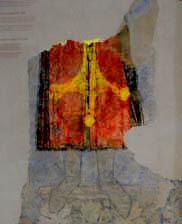  "Beneath a nearby pillar next to his tomb, in fresco paint, a form shrouded in a scarlet tunic, its middle bearing the great Cross of Toulouse, patoncé, and 12 gold bezants thereon" "Beneath a nearby pillar next to his tomb, in fresco paint, a form shrouded in a scarlet tunic, its middle bearing the great Cross of Toulouse, patoncé, and 12 gold bezants thereon"
On the right is an enhanced version showing the lower arm of the great cross that Lardier was describing.
Richard of Toulouse
  Raymond was the son of Raymond VI of Toulouse and Jeanne of England, and brother of Raymond VII of Toulouse. Raymond was the son of Raymond VI of Toulouse and Jeanne of England, and brother of Raymond VII of Toulouse.
The Abbey has two sets of arms of Toulouse. It is possible that one of them represents Richard of Toulouse who died here in childbirth, though they are not differenced by any mark of cadency. Richard's tomb is unknown. Perhaps he was buried with his mother Jeanne who also died here, apparently at the same time as her son Richard, named after his uncle, Richard the Lionheart.
Photo Gallery
|















 Eléanor d'Aquitaine)
Eléanor d'Aquitaine)




























